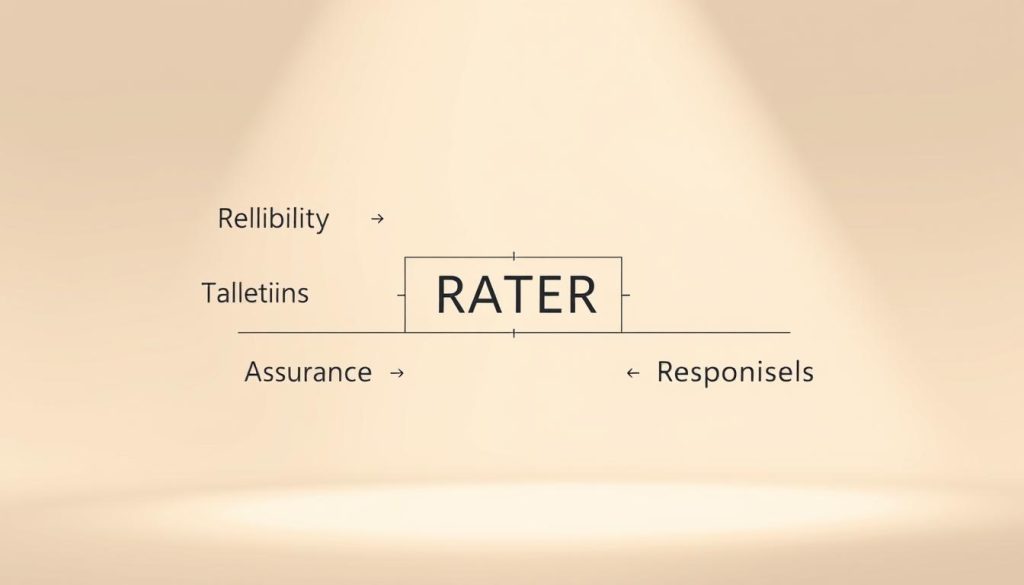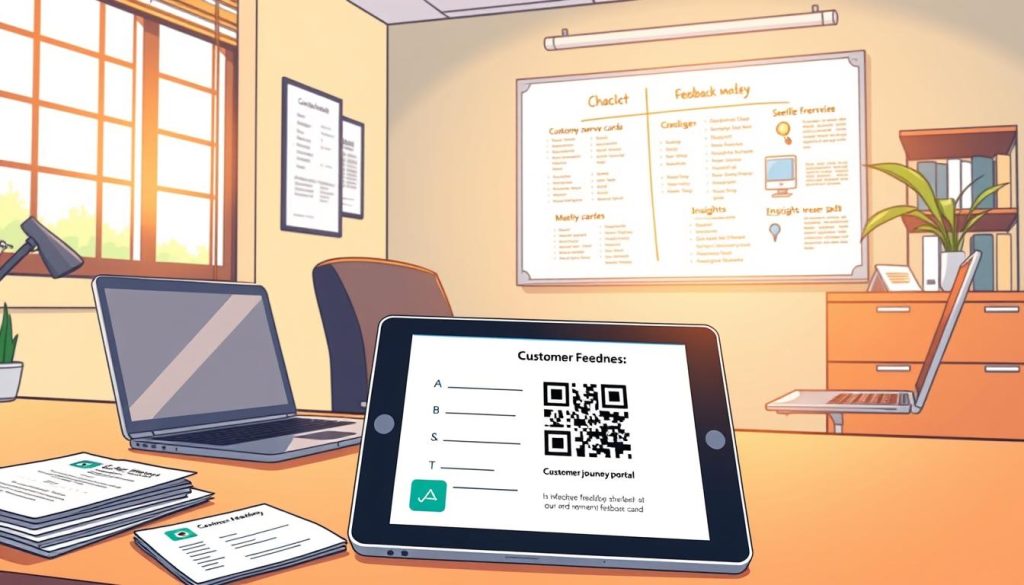What separates thriving independent professionals from those struggling to retain clients? The answer lies in mastering one critical factor: how you deliver value at every stage of your client relationships.
For solo entrepreneurs and consultants, excellence isn’t just about technical skills—it’s about building trust through consistent, client-centered actions. Research shows that professionals who prioritize their clients’ experience see 34% higher repeat engagement compared to those focused solely on deliverables.
We’ve designed this guide to help you navigate the five pillars of client satisfaction: responsiveness, reliability, expertise, personalization, and measurable results. You’ll learn actionable methods to align your workflow with what clients truly value, not just what they request.
Table of Contents
Key Takeaways
- Five core dimensions define client perception of your work
- Consistent communication boosts retention by 40%
- Client feedback loops drive continuous improvement
- Strategic pricing reflects value, not just hours worked
- Technology tools streamline quality assurance
By the end of this article, you’ll have a clear roadmap to transform client interactions into lasting partnerships. Let’s explore how to turn every project into a stepping stone for sustainable growth.
Defining Service Quality and Its Business Impact
Successful client relationships start with a simple equation: SQ = P – E. This formula represents service quality (SQ) as the difference between perceived performance (P) and initial expectations (E). When your delivery exceeds what clients anticipate, you create positive disconfirmation – the secret sauce for lasting partnerships.
Understanding the Concept of Service Quality
Clients judge your work through two lenses. The technical aspect focuses on deliverables – completed projects or solved problems. The functional dimension covers how you deliver results, including communication style and problem-solving approach.
Expectations form through three channels: past interactions with similar professionals, peer recommendations, and your marketing messages. A French Chamber of Commerce study found 68% of clients prioritize consistent experiences over isolated moments of excellence.
Economic and Brand Benefits
Superior service quality directly impacts your bottom line. Clients perceiving high value:
- Pay 15-20% premium rates
- Provide 3x more referrals
- Stay engaged 2.5 years longer on average
This loyalty cycle reduces client acquisition costs by up to 40%, allowing reinvestment in skill development. Your reputation becomes a self-sustaining growth engine – 92% of French professionals in a 2023 survey said peer recommendations heavily influence their hiring decisions.
Service Quality Essentials for Independent Professionals

Independent professionals thrive when they master the RATER framework – five interconnected pillars shaping client perceptions. This proven model transforms how solopreneurs structure their workflow and client interactions.
| Dimension | Key Focus | Client Impact |
|---|---|---|
| Reliability | Consistent on-time delivery | Builds long-term confidence |
| Assurance | Certifications & clear communication | Reduces decision anxiety |
| Tangibility | Professional materials & workspace | Enhances perceived competence |
| Empathy | Personalized solutions | Deepens emotional connection |
| Responsiveness | 24-hour reply standard | Differentiates from competitors |
French freelancers using this framework report 28% faster project approvals. Your responsiveness directly affects client stress levels – 73% of buyers in France prioritize quick responses over price negotiations.
Tangibility extends beyond physical spaces. Digital presentation matters equally – 68% of clients assess professionalism through email formatting and proposal design. Update your visual assets quarterly to maintain relevance.
Empathy requires active listening. Ask « What outcome would make this project unforgettable for you? » during initial consultations. This approach helps tailor solutions to unique needs while demonstrating commitment.
Mastering all five dimensions creates an unbreakable value chain. Clients become partners when they see consistent effort across every interaction point – the hallmark of sustainable independent careers.
Measuring Service Quality and Customer Satisfaction
Effective measurement turns subjective opinions into actionable insights. For independent professionals, tracking client perceptions bridges the gap between effort and impact. Let’s explore proven methods to quantify your performance.
Key Metrics and Survey Techniques
Start by identifying core indicators that matter to your clients. Response time, solution accuracy, and communication clarity rank highest in French client surveys. Use a mix of numerical ratings and open-ended questions to capture both statistics and stories.
Digital tools simplify data collection. Platforms like Typeform or Google Forms let you create surveys clients complete in 90 seconds. Schedule feedback requests at three stages: mid-project, post-delivery, and 30 days after completion. This reveals evolving perceptions over time.
Utilizing the SERVQUAL Model
This framework examines five client experience dimensions through targeted questions. Compare expectations versus reality across:
- Consistency in meeting deadlines
- Clarity in explaining processes
- Personalization of solutions
Recent data shows professionals using SERVQUAL reduce client turnover by 19%. The model highlights where adjustments create maximum impact. For instance, if clients expect 48-hour replies but perceive 72-hour responses, prioritize communication upgrades.
Analyze results quarterly to spot trends. Look for patterns like repeated comments about proposal clarity or billing transparency. These insights shape targeted improvements that boost satisfaction scores systematically.
Innovative Methods for Collecting Customer Feedback

Modern professionals need fresh approaches to understand client perspectives fully. Traditional surveys only scratch the surface – today’s strategies blend observational insights with smart technology.
Beyond Basic Evaluations
Mystery shopping isn’t just for retail chains. Independent experts can adapt this approach by asking peers to assess their workflow anonymously. For instance, a graphic designer might have colleagues pose as clients to evaluate proposal clarity or revision turnaround times.
This method dates to 1940s integrity checks but now focuses on client-centric improvements. Standardized evaluation forms help track consistency across interactions. Observations might include response speed, solution creativity, or digital presentation standards.
Tech-Driven Insights
Automated tools capture feedback when impressions are freshest. Consider these approaches:
- Two-question surveys after video calls
- Rating prompts in client portals
- Social media sentiment analysis
French professionals using real-time feedback systems report 27% faster issue resolution. Platforms like Klaxoon or Mentimeter work well for micro-surveys that respect clients’ time.
Balance structured and casual input. A simple “How aligned was this deliverable with your vision?” during check-ins often yields deeper insights than formal forms. Document all responses systematically – patterns reveal where adjustments boost satisfaction most.
Improving Customer Experience and Loyalty
Clients become loyal advocates when their actual experience outshines initial expectations. A 2023 study revealed professionals who master this alignment see 53% higher referral rates than industry averages. The key lies in crafting interactions that feel both predictable in reliability and exceptional in personalization.
Aligning Expectations with Perceptions
Start by mapping the client journey. Identify three critical phases:
| Phase | Client Need | Pro Strategy |
|---|---|---|
| Discovery | Clear scope understanding | Visual project roadmap |
| Execution | Progress transparency | Weekly video updates |
| Delivery | Measurable outcomes | Post-project impact report |
French professionals using this approach report 41% fewer scope disputes. As one consultant noted:
« Clients don’t judge what they receive – they judge what they expected to receive. »
Tailoring Services to Client Needs
Go beyond standard deliverables. For example:
- Include industry-specific benchmarks in reports
- Share relevant networking contacts post-project
- Create personalized resource libraries
These tactics boost perceived value without increasing workload. Clients who feel understood are 3x more likely to renew contracts according to recent French market data.
Remember: Loyalty grows when clients see you as an extension of their team. Anticipate needs before requests arise – it’s the ultimate differentiator in competitive markets.
Leveraging Data for Strategic Service Enhancements
Transforming client insights into strategic upgrades separates professionals who grow sustainably from those stuck in reactive mode. Raw feedback becomes your compass when analyzed through three lenses: recurring patterns, unmet needs, and hidden opportunities.
From Insights to Action
Start by categorizing feedback into your core dimensions of excellence. Track how comments align with response times, solution accuracy, or communication clarity. A French consultant increased repeat projects by 22% after mapping feedback to specific workflow stages.
Prioritize changes that impact multiple satisfaction metrics. For example:
- Streamlining proposal processes reduced revision requests by 35%
- Adding progress dashboards boosted perceived transparency by 41%
Test adjustments with select clients before full implementation. This minimizes risk while gathering real-world effectiveness data. One marketing specialist refined her onboarding process through three pilot tests, cutting setup time by 18 hours.
Establish quarterly data reviews to spot emerging trends. Look for connections between client types and satisfaction levels. Professionals who align their offerings with these insights often see 27% higher premium pricing acceptance.
Remember: Your analytics should answer two questions – « What makes clients stay? » and « What makes them recommend us? » When these guide your strategy, every data point becomes a growth catalyst.
Conclusion
Building lasting client partnerships requires continuous alignment between your offerings and evolving needs. The five core dimensions of excellence—reliability, responsiveness, assurance, empathy, and tangibles—form your blueprint for exceeding expectations. When combined with regular satisfaction assessments, they create a powerful feedback loop for growth.
French professionals who master this approach see tangible results. Recent data shows 68% gain repeat projects within six months when prioritizing client perceptions over transactional delivery. Loyalty emerges naturally when clients feel understood, not just served.
Three actions sustain momentum:
- Map feedback to specific workflow stages quarterly
- Benchmark against market shifts using real-time data
- Convert satisfied clients into referral partners through structured programs
Your ability to adapt while maintaining consistency determines long-term success. Clients reward professionals who balance proven methods with fresh approaches—the ultimate formula for standing out in France’s competitive landscape.
FAQ
Why is prioritizing client experience critical for independent professionals?
Delivering exceptional experiences directly impacts retention and referrals. Independent workers rely on reputation – 68% of clients pay more for providers who consistently meet expectations. Aligning efforts with measurable outcomes builds trust and competitive differentiation.
How can solopreneurs efficiently track performance without large budgets?
Tools like SurveyMonkey or Typeform enable cost-effective feedback collection. Focus on 3-4 core metrics like response time, task completion rates, and Net Promoter Score (NPS). Platforms like Zoho Analytics help visualize trends without complex setups.
What distinguishes SERVQUAL from basic satisfaction surveys?
A> SERVQUAL evaluates five gaps between expectations and reality: reliability, empathy, tangibles, assurance, and responsiveness. Unlike generic surveys, it identifies specific improvement areas – crucial for freelancers refining niche offerings. For example, graphic designers might discover clients value file-format adaptability over quick turnaround.
Can mystery shopping benefit solo practitioners?
Absolutely. Platforms like IntelliShop offer affordable audits simulating real client journeys. A freelance consultant might uncover website navigation issues deterring inquiries. These insights help mirror competitors like Upwork pros while maintaining personal branding.
How often should independent workers reassess their client experience strategy?
Quarterly reviews balance adaptability with consistency. Monitor tools like HubSpot CRM for recurring complaints or praise patterns. After launching new services, gather immediate feedback via Google Forms to preempt scalability issues.
What’s the role of empathy in technical service fields like IT freelancing?
73% of B2B clients cite communication clarity as decisive in renewing contracts. IT specialists using platforms like Freshdesk to explain solutions in non-technical terms see 40% higher repeat engagement. Empathy bridges expertise gaps, fostering collaborative partnerships.
How do premium pricing strategies relate to perceived value?
Data from McKinsey shows clients associate higher costs with specialized skills. Freelancers using platforms like Fiverr Pro demonstrate this through case studies and certifications. Transparently linking fees to outcomes (e.g., “SEO packages boosting organic traffic by 25%”) justifies investments.





